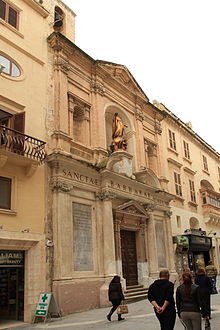Giuseppe Bonici

Giuseppe Bonici (1707–1779) was a Maltese architect[1] and military engineer. He held the post of Capomastro delle Opere della Religione and was the principal architect of the Order of St. John from 1761 until his death. He designed several notable buildings; his masterpiece was the Customs House in Valletta.
Biography
Bonici began drawing architectural plans at a young age, and he was apprenticed to the Maltese architect Giovanni Barbara and later the French military engineer René Jacob de Tigné. He made plans for the St. Publius Parish Church in Floriana in 1734, which solidified his fame as a master of religious architecture. His masterpiece is the Customs House in Valletta, which he designed in 1774.[2][3] Bonici mainly designed buildings in the Baroque style, even when the style was being superseded by neoclassical architecture in the rest of Europe.[4]
Bonici held a number of positions throughout his career, including a substitute engineer at the Commissari Domorum, an examiner of those aspiring to be land surveyors, and Capomastro delle Fortificazioni della Fondazione Cotoner. Most notably, he held the post of Capomastro delle Opere della Religione, being the principal architect of the Order of St. John, from 1761 to his death in 1779. Bonnici was also a member of the Monte della Redenzione degli Schiavi and a donat of the Order.[2]
List of buildings attributed to Bonnici

The following buildings are known to have been designed by Bonnici or are attributed to him:[1][2][5][6]
- Church of the Immaculate Conception, Cospicua (1730) – attributed
- St. Publius Parish Church, Floriana (1734) – nave only, with other architects
- Church of St. Barbara, Valletta (1737)
- Castellania, Valletta (1758–60) – built to designs of Francesco Zerafa
- Basilica of St. Peter & St. Paul, Nadur (1760) – attributed
- Church of St. Bartholomew, Tarxien (1764) – attributed
- Church of St. Augustine, Valletta (1765) – completed by Antonio Cachia
- Customs House, Valletta (1774)
- The fountains at St George Square/Palace Square in Valletta.[7]
Further reading
- Art and architecture in Malta in the early nineteenth century Archived 2016-10-11 at the Wayback Machine. pp. 4–6.
- More works and information
- Representation of architects and building projects in seicento and settecento local art, Malta
References
- ^ a b Gaul, Simon (2007). Malta, Gozo and Comino. New Holland publishers. p. 325. ISBN 9781860113659.
- ^ a b c Schiavone, Michael J. (2009). Dictionary of Maltese Biographies Vol. 1 A-F. Pietà: Pubblikazzjonijiet Indipendenza. p. 237. ISBN 9789993291329.
- ^ "One World - Protecting the most significant buildings, monuments and features of Valletta - The Old Customs House and statue of St Publius". Times of Malta. 2 March 2009. Retrieved 2 August 2016.
- ^ Bugeja, Lino (4 January 2015). "Valletta – vibrant city of many styles". Times of Malta. Archived from the original on 4 March 2016.
- ^ Myers, Bernard Samuel (August 4, 1959). Encyclopedia of world art. McGraw-Hill – via Internet Archive.
jean pratt Valletta and its architecture.
- ^ Perkins, J. B. Ward (August 4, 1942). "Medieval and Early Renaissance Architecture in Malta". The University Press – via Google Books.
- ^ Muscat, Joseph (June 2012). "The Monumental Church of Nadur" (PDF). The Journal of the University of Malta-Gozo Campus (UGC) (26). Gozo Observer: UGC Publications: 27. Archived from the original (PDF) on 10 January 2017.
